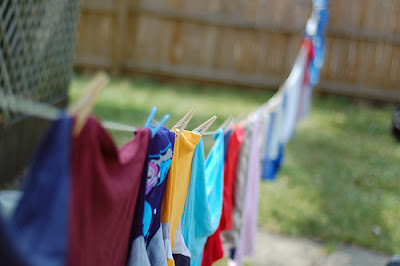What They Wear
"I've got halo's made of summer, rhythms made of spring
What she wears, what she wears, what she wears
I've got crowns of words a woven, each one a song to sing
Oh I sing, oh I sing, oh I sing"
- "Something In The Water", by Brooke Fraser
A teenage girl wears jeans with a large, sequined Playboy Bunny symbol covering one thigh. The sequins are red, white, and blue: a tribute to an unfortunate American creation. It's likely the teenager has no idea exactly what the bunny symbolizes, just as many t-shirts with phrases in English (sometimes grammatically incorrect) are popular, despite the fact that the wearers often do not know their meanings. It is shiny and eye-catching and that is enough.
A young man, around 19 if I were to guess, boards the bus in jeans, a suit coat, and no shirt underneath. The long V of the jacket exposes his chest, and - along with his carefully styled hair and dark sunglasses - he looks like a displaced boy band member, an attempted emblem of 'cool' stuck in the middle of a normal day.
An indigenous family crosses the street in traditional garb. The women wear lacy, embroidered white shirts tucked into a long piece of dark cloth which is wound around their waist as a skirt and held in place with an intricately woven belt. They wear shoes which resemble house slippers with hard, flat soles. Their hair is worn in long braids, and necklaces with layer upon layer of delicate beads adorn their throats. The men also often wear white, embroidered shirts, just plainer and without any lace, often with ponchos layered over them. Both women and men wear fedoras to protect them from the sun.
A woman walks past wearing a shirt which leaves part of her stomach exposed. She is not thin or young but unlike in the States, these things do not seem to bother people here. Just as tight, brightly-colored leggings (or flesh-colored ones) are worn as pants without any attempt to cover one's butt. I have never found this look to be flattering, personally, preferring to wear legging only under a dress or a tunic-length shirt which covers my hips. Different perspectives from different cultures.
I wonder, in return, what people think when they see me. When I wear a long skirt, or flip-flops (which are not common here), or something which shows the open-book tattoo on my back. What do they sum up about what I wear? Clothes are this curiously outward expression of more than simply style. Some people like to stand out and proclaim their individuality. Some prefer to carefully follow current trends, while some chose clothes in order to not draw attention to themselves. Styles across different countries fascinate me, as well as people's choices. Then, there are people who are grateful for any clothing at all, t-shirts and pants scrounged up or donated. Everything in perspective, everything some part of someone's story.

Comments